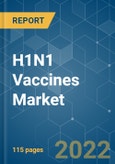The H1N1 Vaccines Market is expected to register a CAGR of 5.2% during the forecast period. The H1N1 virus, commonly known as swine flu is an infectious disease in humans caused by the swine H1N1 virus, which is characterized by a persistent cough, cold, high fever, red watery eyes, body aches, headache, and general discomfort. H1N1 virus affects various species such as swine, birds, horses and other animals. The H1N1 virus is contagious and can spread widely through small droplets of saliva from coughs or sneezes of infected person. H1N1 virus causes damage to the respiratory system including nose, lungs, and throat. The H1N1 virus is a Ribonucleic acid (RNA) virus belonging to the Orthomyxoviridae family. In the year 2009, a strain of swine flu called "H1N1" infected many people around the world.
According to the World Health Organization (WHO), annually about 3 to 5 million cases of severe illness and about 2,90,000 to 6,50,000 respiratory deaths are due to seasonal influenza. In the case of industrialized countries, most of the deaths due to influenza occur among people above 65 years of age. Seasonal influenza illnesses range from mild to severe and even death.
Increasing incidences of epidemic H1N1 infection and declining immunity among the geriatric population and technological advancements in the vaccines are the key driving factors in the H1N1 vaccines market.
Key Market Trends
Intramuscular Vaccines Segment is Expected to Witness a Rapid Growth
An intramuscular injection is a procedure used to deliver a medication deep into the muscles which allows the medication to be absorbed into the bloodstream quickly. Intramuscular injections are absorbed faster than subcutaneous injections because muscles have a greater blood supply than the tissue present under the skin. Moreover, muscle tissue can also hold a larger volume of medication than subcutaneous tissue. According to the 2017 United Nations report, the global population is crossing the age of 60 at an annual rate of 3% which maximizes the risk of various diseases such as respiratory tract disorders and immune deficient diseases, thereby the risk for infection due to H1N1 virus rises.
The intramuscular vaccines segment holds a significant market share in the H1N1 vaccines market and is anticipated to show a similar trend over the forecast period. Rising incidences of swine flu and the need for H1N1 vaccination is increasing and increased risk of respiratory diseases and immune-deficient diseases among the geriatric population are the key driving factors in the intramuscular vaccines segment.
North America is Expected to Hold a Significant Share in the Market and Expected to do Same in the Forecast Period
North America is expected to hold a major market share in the H1N1 vaccines market due to increasing government initiatives for the prevention of H1N1 infection and improved research infrastructure in this region. According to the Centers for Disease Control (CDC), about 8 percent of the United States population gets sick from the flu. In addition, approximately 31.4 million people visit the doctor and 200,000 people end up in the hospital every flu season. Moreover, technological advancements in the vaccines field and the presence of well-established healthcare infrastructure are also fueling the growth of the overall regional market to a large extent.
Competitive Landscape
The H1N1 Vaccines Market is consolidated and consists of a few major players. In terms of market share, few of the major players are currently dominating the market. Some of the companies which are currently dominating the market are MedImmune LLC (AstraZeneca PLC), Sanofi Pasteur AG, GlaxoSmithKline Plc, Abbott Laboratories, CSL Limited (Seqirus GmbH), Pfizer Inc, CPL Biologicals Pvt. Ltd, Mitsubishi Tanabe Pharma Corporation, Sinovac Biotech Ltd and Zydus Cadila.
Additional Benefits:
- The market estimate (ME) sheet in Excel format
- 3 months of analyst support
This product will be delivered within 2 business days.
Table of Contents
Companies Mentioned (Partial List)
A selection of companies mentioned in this report includes, but is not limited to:
- MedImmune LLC (AstraZeneca PLC)
- Sanofi Pasteur AG
- GlaxoSmithKline Plc
- Abbott Laboratories
- CSL Limited (Seqirus GmbH)
- Pfizer Inc
- CPL Biologicals Pvt. Ltd
- Mitsubishi Tanabe Pharma Corporation
- Sinovac Biotech Ltd
- Zydus Cadila
Methodology

LOADING...








